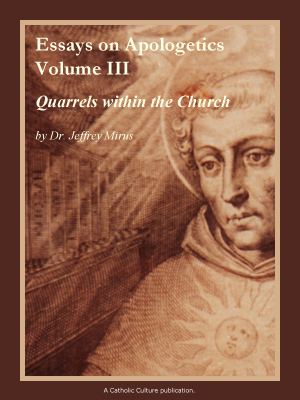Catholic World News News Feature
The bear and the scallop-shell-- a unique papal coat of arms April 27, 2005
Pope Benedict XVI has included his old Bavarian homeland in the papal coat of arms.
All of the elements in the episcopal coat of arms that Cardinal Joseph Ratzinger bore as Archbishop of Munich and Freising and then as the prefect of the Congregation for the Doctrine of the Faith have become part of his papal coat of arms as well.
The coat of arms appeared for the first time in an official commemorative picture that was published by the Vatican on the occasion of the installation of the new Pope; the heraldic insignia are presented there in an outline sketch, however, and not in full color.
The Archdiocese of Munich enumerates the elements on the coat of arms in an article posted at its website.
The shield, which is divided into three sections, displays the “Moor of Freising." The Moor’s head, facing left and typically crowned, appeared on the coat of arms of the old principality of Freising as early as 1316, during the reign of the Bishop of Freising, Prince Konrad III, and it remained almost unchanged until the “secularization” of the Church’s estates in that region in 1802-1803. Even after that time all the archbishops of Munich and Freising have included the Caput Aethiopum, the head of an Ethiopian, in their episcopal coat of arms.
An especially distinctive element in the new papal coat of arms is a bear with a pack-saddle, the so-called “Bear of Corbinian." There is a charming legend involving a bear that is told about Bishop Corbinian, who preached the Christian faith in the ancient Duchy of Bavaria in the 8th century and is honored as the spiritual father and patron of the archdiocese. It is said that while he was traveling to Rome a bear mauled his pack-animal. The saint then rebuked the wild beast, and commanded the bear to carry his packs to Rome. Once he arrived there, however, he let the bear go, and it lumbered back to its native forest. The meaning of the legend is clear: Christianity tamed and domesticated the ferocity of paganism and thus laid the foundations for a great civilization in the Duchy of Bavaria. At the same time, Corbinian’s Bear, as “God’s beast of burden,” symbolizes the burden of office. In the coat of arms of Benedict XVI, the Bear of Corbinian has now taken up permanent residence in Rome.
The third element, the shell, has several symbolic meanings. First it refers to a famous legend about St. Augustine, Bishop and Doctor of the Church (354-430 AD). Once as he was walking along the seashore, meditating about the unfathomable mystery of the Holy Trinity, he met a boy who was using a shell to pour seawater into a little hole. When Augustine asked him what he was doing, he received the reply, “I am emptying the sea into this hole.” Thus the shell is a symbol for plunging into the unfathomable sea of the Godhead. It also has a connection, though, with the theologian Joseph Ratzinger and the beginning of his academic career. In 1953 he received a doctorate in theology under Professor Gottlieb Söhngen at the University of Munich by completing a dissertation on “The People of God and the House of God in Augustine’s Teaching about the Church."
Furthermore, the shell also stands for “Jacob’s staff,” a pilgrim’s staff topped with a scallop shell, which in Church art was the symbol of the apostle James (in Latin, Jacobus). In this sense, the symbol alludes to a central concept of the Second Vatican Council, the “pilgrim people of God,” which the theologian shepherded locally as Archbishop Ratzinger and of which he is now, as Benedict XVI, the universal shepherd. When he became an archbishop he deliberately incorporated this symbol also in his coat of arms as “Jacob’s staff.” It was found in the heraldic insignia of the Schottenkloster in Regensburg, an ancient monastery founded by Irish monks, where the major seminary of that diocese is now located. Thus it also recalls a place where the Pope once lived and worked as a professor of theology. From 1969 until his appointment as Archbishop of Munich and Freising in 1977 he taught dogmatic theology and the history of doctrine at the University of Regensburg.
As his episcopal motto, Cardinal Ratzinger had again shown his background as a theologian, choosing the phrase "cooperators veritatis "-- collaborators of the truth. The Vatican has not yet disclosed whether Benedict XVI will use the same phrase as his papal motto.






